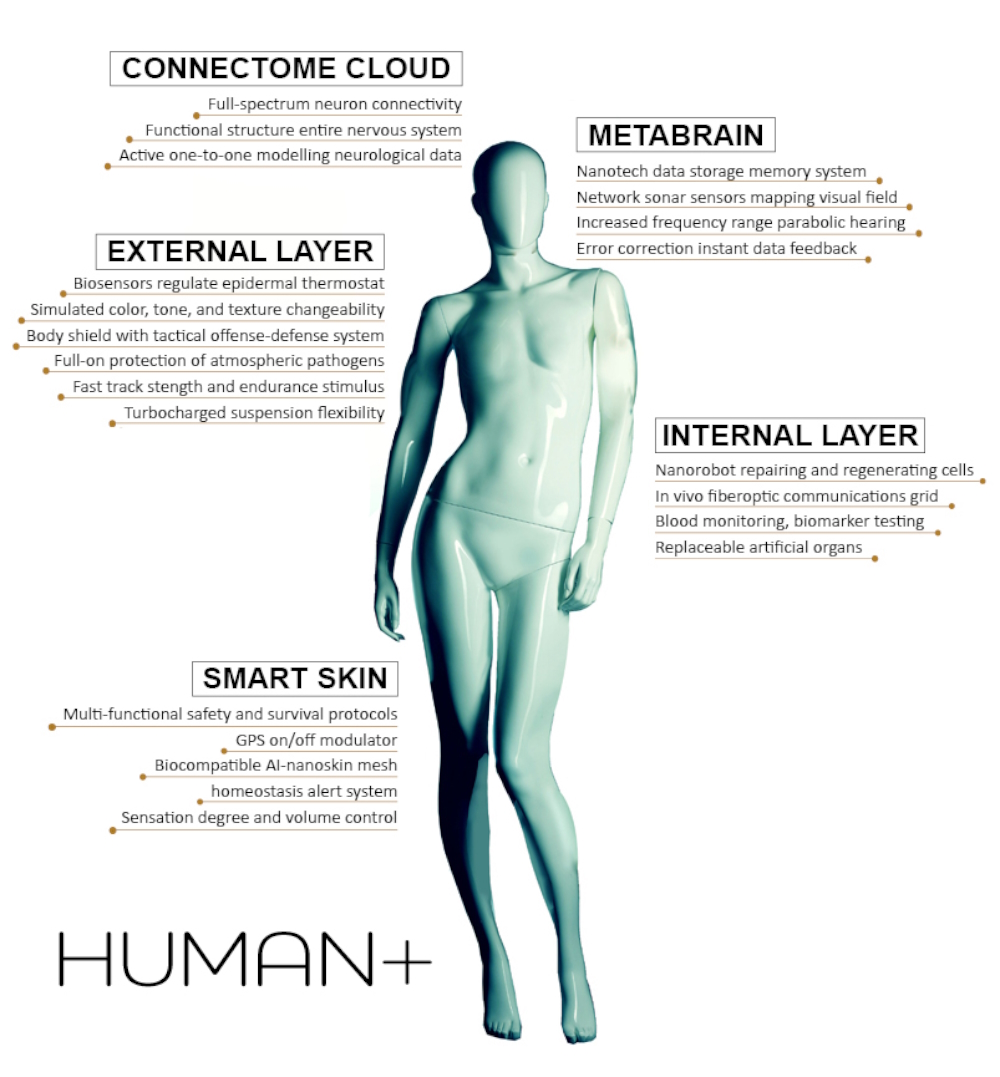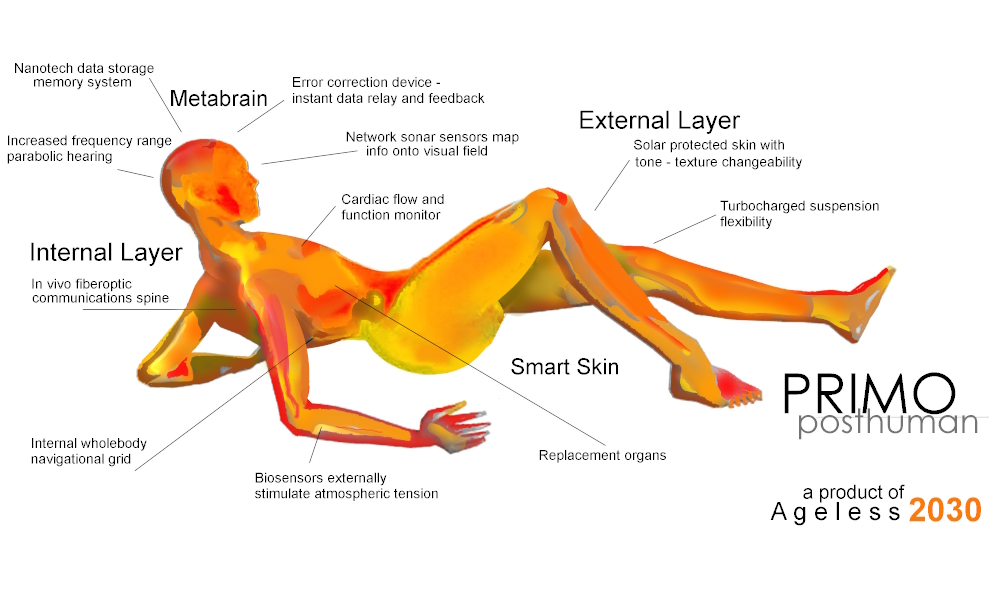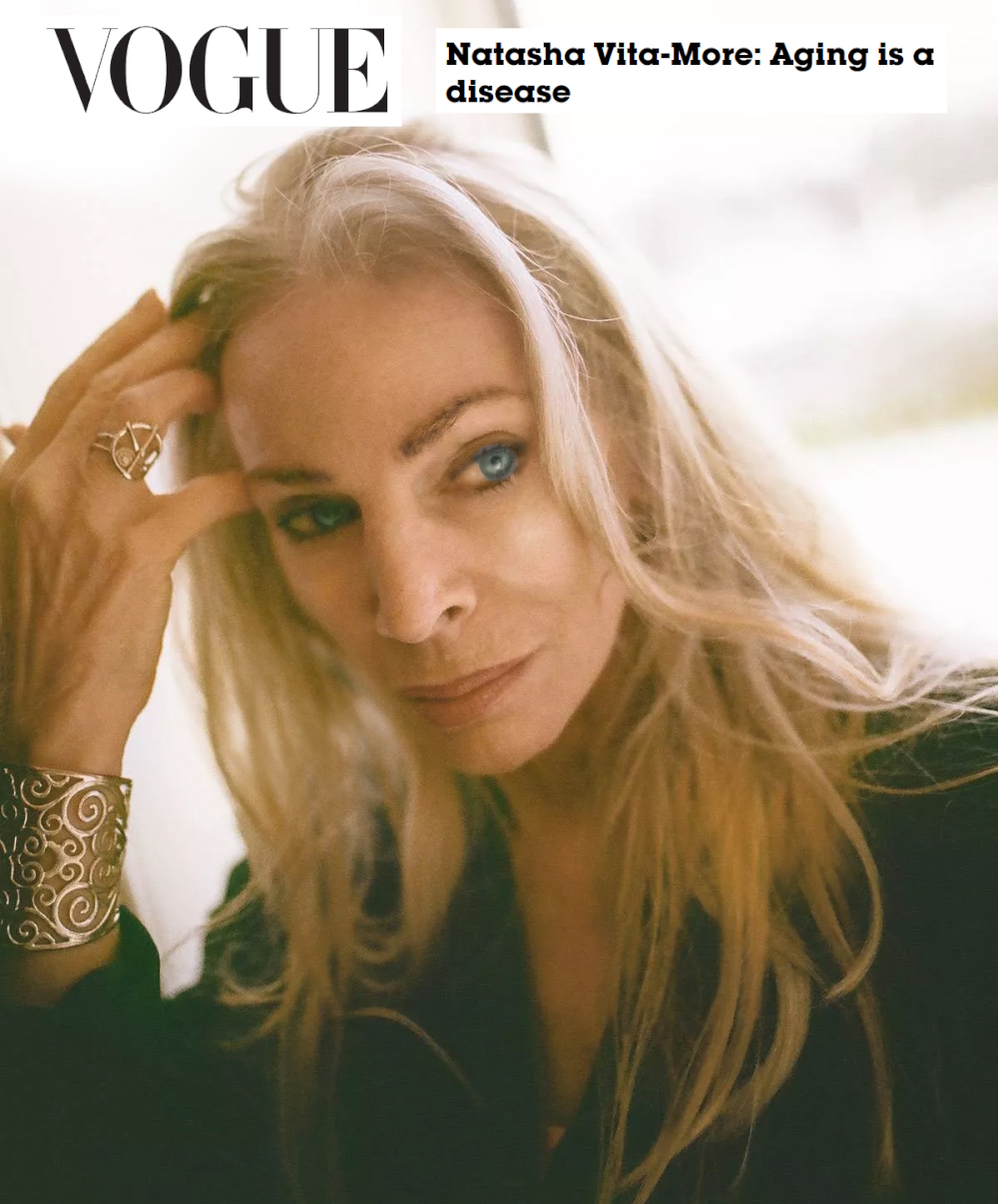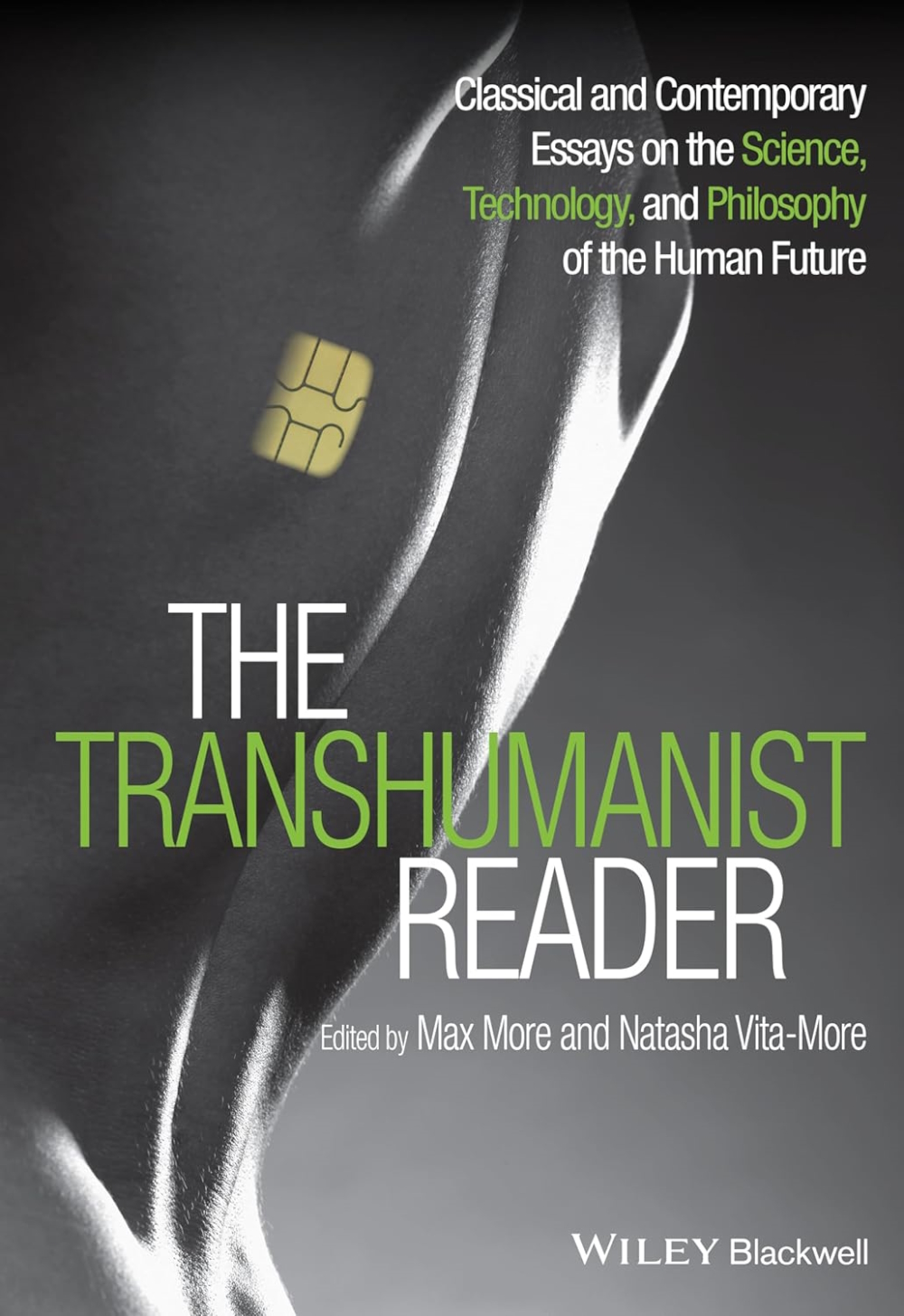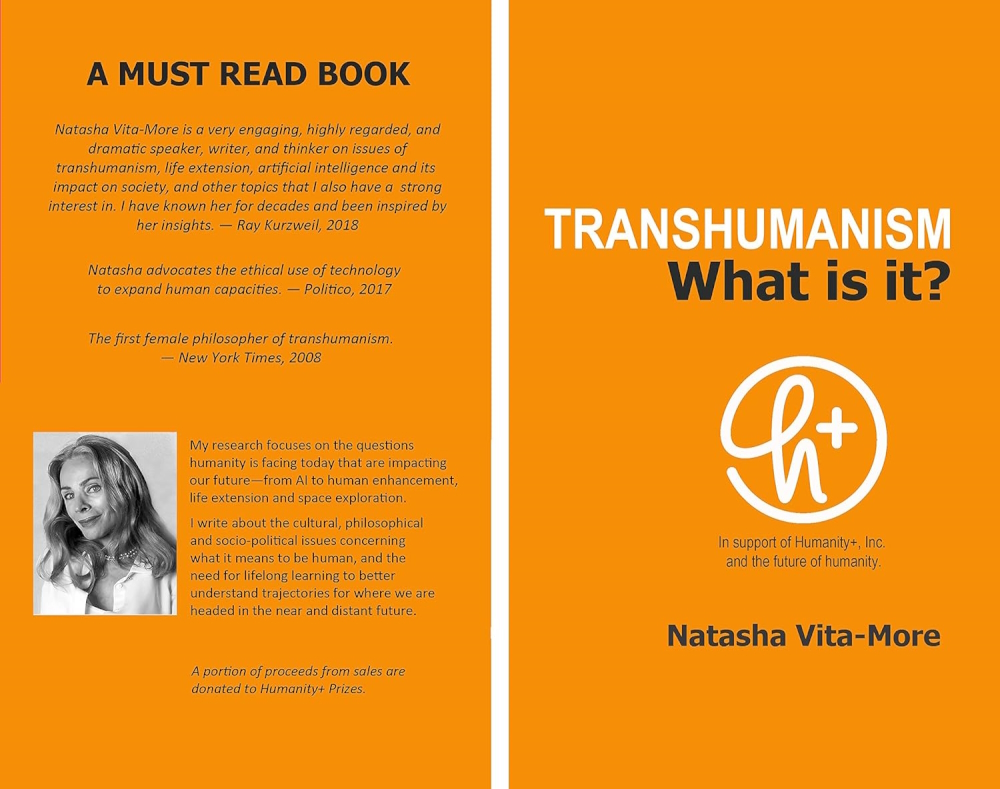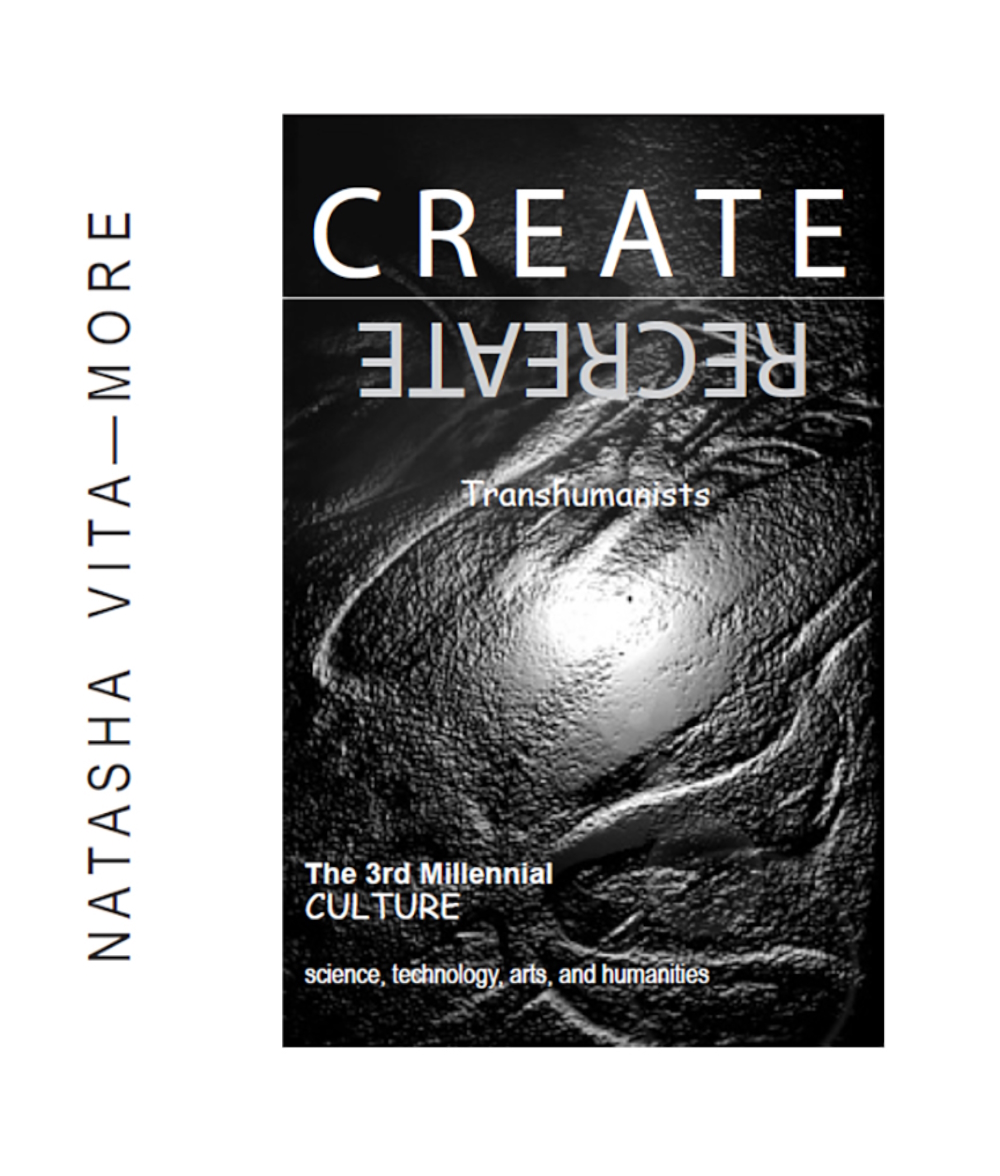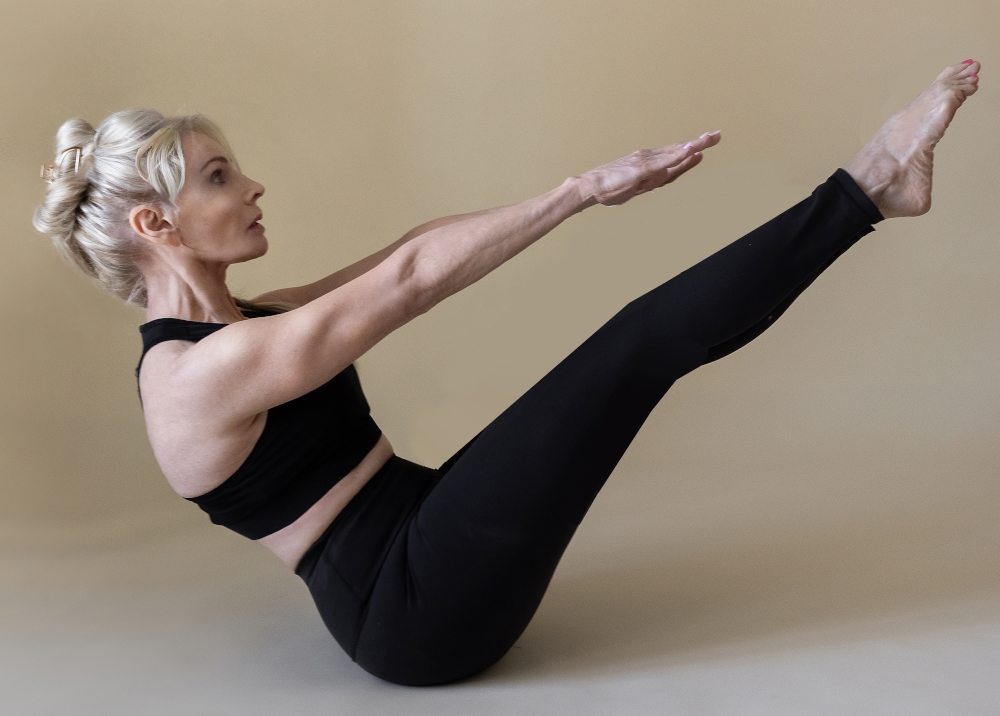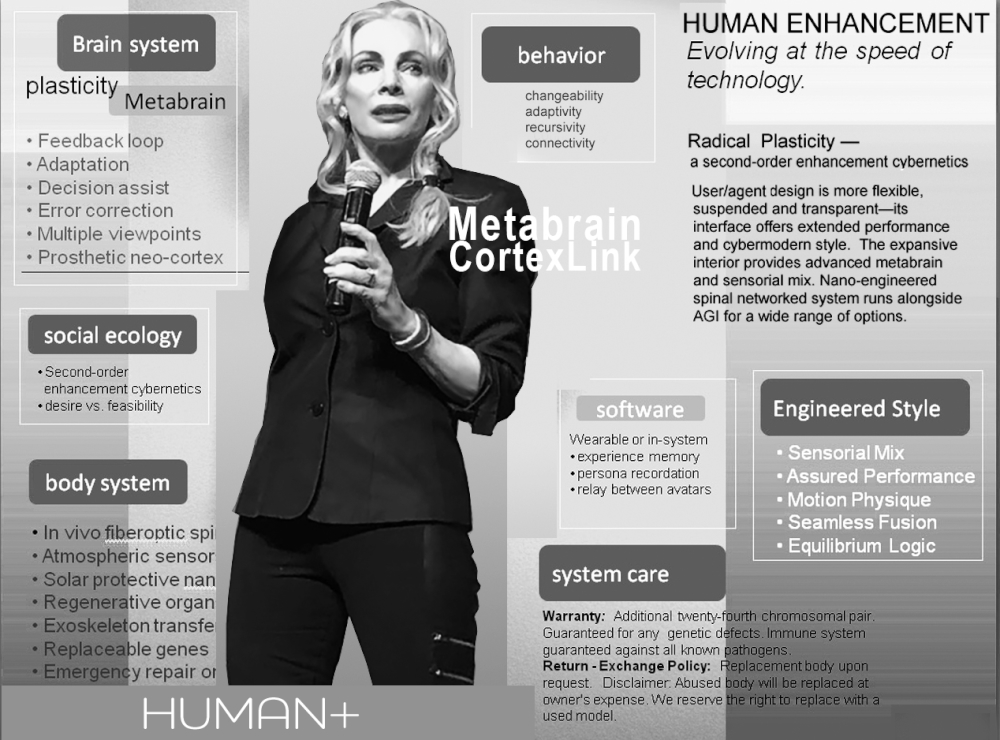Natasha Vita-More
strategic designer in human enhancement and life extension
USA
Designing the first future body prototype called “Primo Posthuman“, a new genre of the human, is her project which has had the greatest impact. It has been featured – amongst others - in The New York Times, Wired, Harper’s Bazaar, U.S. News & World Report. The woman in question is a community leader. Her “TransCentury Update” cable TV show produced in Los Angeles from 1985-1992, featured ideas about the future. Yet, in her early years of philosophy, she was a true pioneer of transhumanism. This is a philosophical worldview based on “the idea that technology and evidence-based science can and should be used to augment and improve humans in order to overcome the limitations that evolution has left us with“ (forbes.com). Because of her innovations this thought leader that has “worked as a designer, a philosopher, an educator, a scientist and a movement builder“ (forbes.com) was named one of the Top-50 Women of Longevity Leaders! The impetus for her becoming this “very engaging, highly regarded, and dramatic speaker, writer, and thinker on issues of life extension, artificial intelligence and its impact on society“ (quote from famous computer scientist Raymond Kurzweil on her own website) is to be found in a very personal situation that many might share, but very few draw immediate consequences from like she did.
Natasha Vita-More
strategic designer in human enhancement and life extension
USA
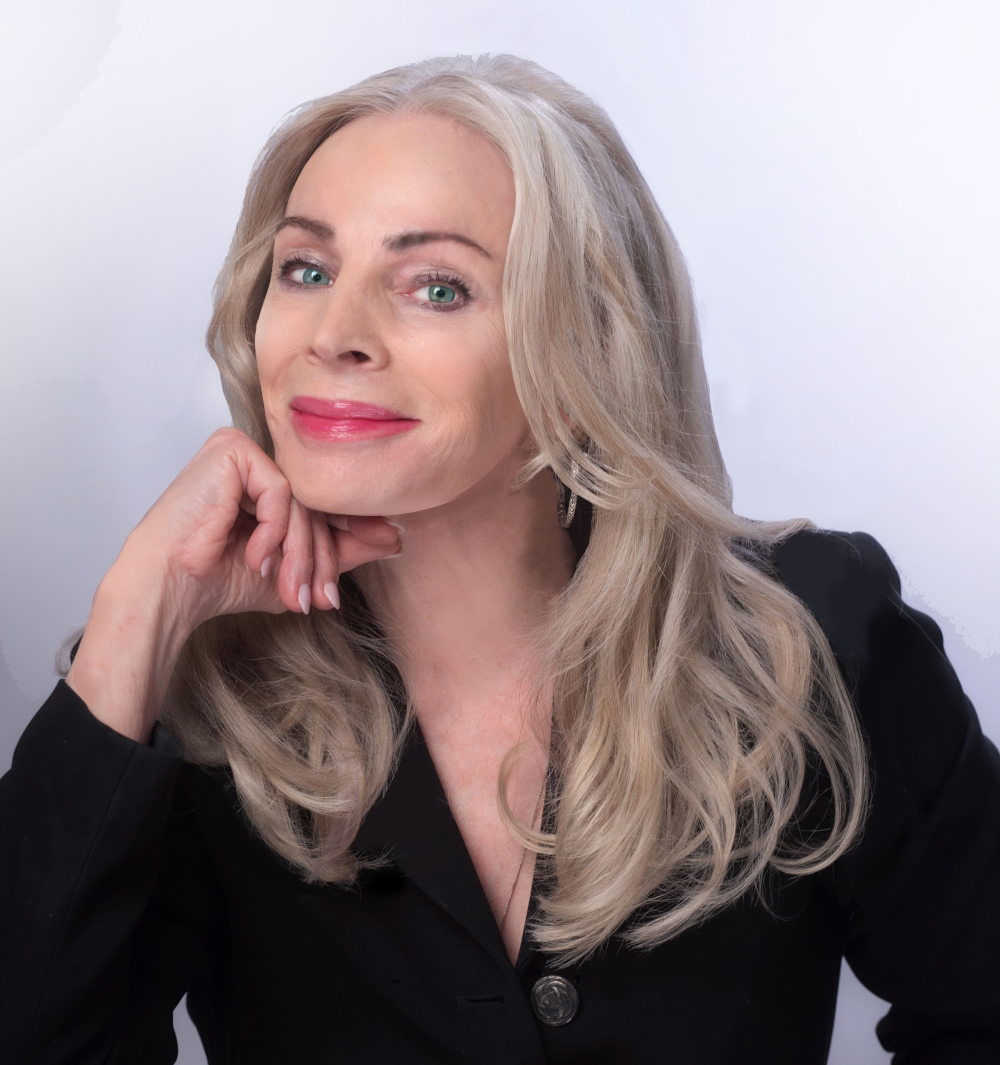
“I first became interested in the future of culture, arts, science and technology in 1979 while I was living in a ski resort in Colorado“, Natasha Vita-More is quoted on medium.com. “It was there that I had time, and volumes of space, to rethink my life and the future.“ While for most people this might just be a temporarily mind game, the lady from Bronxville/New York (* February 22, 1950) grasped the opportunity and gave her life a new turn. While her family favored her to pursue a career in medicine, she studied at Accademia di Belle Arti in Ravenna, Italy, graduated with a Bachelor of Fine Art and started a commercial design firm in Telluride, Colorado. Cut and switch to the University of Colorado in Boulder for becoming a filmmaker-in-residence, who made the short film “Breaking Away” which symbolized humanity’s breaking away from outdated myths and stale dogma. Next stop: Los Angeles. During this time Natasha Vita-More who “was drawn to future-oriented ideas from an early age on, but felt they were too radical to gain widespread acceptance at the time“ (forbes.com) authored the first version of the “Transhumanist Manifesto“ (PDF on www.humanityplus.org/the-transhumanist-manifesto) which was on board the sophisticated robotic spacecraft Cassini-Huygens Saturn mission. The proclamation discusses the possibility for overcoming disease and extending lifespans. The intensive study of these topics resulted in the foundation of “Human+”, where science and the arts bridge frontiers of longevity as a guide to the next chapter of human evolution. Human+ Podcast — Dr. Natasha Vita-More https://www.natashavita-more.com/human.
A few years onwards the well-traveled intelligentsia completed Paralegal Certification from Blackstone School of Law in 1992, earned a Master of Science in Future Studies at the University of Houston (2006) and a Master of Philosophy from University of Plymouth, UK. Faculty of Technology, School of Computers, Communications and Electronics, School of Communications and Media Studies Master of Philosophy. Vita-More was awarded a Ph.D. in Media Art and Design from the Planetary Collegium of the University of Plymouth for her thesis “Life Expansion”.
Dr. Vita-More has authored numerous publications/articles and various books like “CREATE/RECREATE: the 3rd Millennial Culture “, exhibited her media artworks (videos, paintings) in museums and appears in dozens of televised films and documentaries about humanity's future. Topics include longevity, AI, nanomedicine, human enhancement, emerging and speculative technologies, ecological futures, and social change. A key focus in the work of one of the renowned futurists in the world is on what this busy person has called "radical life extension".
The recipient of several awards is a sought-after spokeswoman at conferences that „merge philosophical reflection with technological advancements. She invites attendees to explore the 'what ifs' of our existence, prompting a re-conceptualization of human life and health. Her talks are immersive and transformative, offering insights on how AI and genetics could expand our cognitive and physical capabilities “(thinkingheads.com).
„My general research focuses on the questions humanity is facing today that are impacting our future—AI, nanomedicine, human enhancement, and healthy longevity. While my scientific research achieved the first known evidence of persistence of long-term memory of simple animals in the cryobiology protocols of vitrification, I am not a seasoned scientist. Rather, I am an innovator who produces projects, one of which was a scientific breakthrough. I innovated the theory of Ageless Thinking, developed university courses on the future of AI, pioneered a whole-body prototype in 1996 known as Primo Posthuman in combining AI, nanorobotics and prosthetics, including Metabrain. I helped to spearhead a cultural movement that was the first philosophy on humanity’s future. I write about the cultural, philosophical, and socio-political issues concerning what it means to be human and an awareness of our trajectory that requires us to reflect on where we are headed. My study examines who or what will govern our future, how we can strategize existential threats and assess the scope of AI and supercomputers, build awareness of cybersecurity, and protect our human rights” (from her website).
A corporate identity is an important part of presenting oneself in public professionally and conveying a well-sought out image. Natasha has maintained her physical and cognitive vitality through her strategic design sensibility by developing a longevity zone of fitness: https://www.natashavita-more.com/longevitypractice. Even her name has a regenerative touch. Born as Nancie Clark, she renewed her forename in memory of her eldest brother who fondly called her Natasha. Vita is the Latin word for life. In combination with her husband’s surname all sums up to “more life“! This perfect match is fully in tune with her passion of developing projects and innovations that support healthy longevity and the biomedical technologies, advances in scientific research, and daily lifestyle:
Dr. Natasha Vita-More, PhD lives in Scottsdale, Arizona and Los Angeles, California.
Interview April 2025
Redifining Humanity: Healthy Longevity
INTUITION/IMAGINATION
?: How does intuition present itself to you – in form of a suspicious impression, a spontaneous visualisation or whatever - maybe in dreams?
Intuition comes to me during moments when everything seems to align. These moments seem like brilliant brain bursts from my imagination, but I know that it is rapid subconscious processing working quietly in the background that sparks gamma waves and release of dopamine. Even if I think that my creativity is entirely unique or sudden epiphany, I understand bursts of intuition are historical brain tools for survival and that the evolved prefrontal cortex forms logical analyses. It all makes sense if our brain is a prediction and pattern-recognition machine.
So, it really does not matter whether intuition is a survival mechanism or a precursor to logic. What matters is how it is experienced and if it takes on a role, purposeful or otherwise. For example, I experience brain bursts in the middle of the night, nearing dawn. Usually around 4:00 AM. I wake up to a flurry of ideas. Sometimes I just watch or listen to what is happening as the ideas take form in my brain, sometimes I jot them down, and sometimes I get up and create.
?: Will any ideas be written down immediately and archived?
For many years, I have been using my published stories as scripts for performances. One was a story about defeat and the emergence of the strength achieved through moments of wonderment. This was filmed inside the Haleakala volcano on the Island of Maui and titled “Sleeping Goddess, Waking Muse”. Another was about the tyranny of aging and social bulling about a person’s chronological age, as it were the “sin quo non” of one’s existence. This became a poetic story about a person who reaches beyond age restraints and continues to be born anew. It is titled “How Old Are You?” Another idea that manifested came about in the exact moment the intuition and produced a visual insight. This painting reflects a life-size image of me looking at me— as if I were calling out to my own shadow. Its message is to pay attention a mental or neural spark and let it go—let it create something that the conscious mind does not judge or interfere with.
?: How do you come up with good or extraordinary ideas?
I like to learn, to listen to others who have a lot of information or experience. So, I pay attention to what they have to say. I watch a lot of educational programs or documentaries, or YouTube videos.
?: Are great ideas based on intuition, and do they reveal themselves in a kind of clear as well complete version that just has to be realized? Or is it endless trials and errors (after the first spark) that result in constant developments up until the final result?
It seems to me that ideas are iterative—they are in a state of becoming and never fully realized unless they are directed toward a specific outcome. The trial and error are part of the iterative process are essential and natural, like an error-correction homeostasis process. All my ideas are the result of prior ideation and become the prognosticators or scaffolds for future ideas.
?: What if there is a deadline, but no intuition? Does the first fuel the latter maybe?
If there is a deadline, there is an intention. If there is an intention it simply means that the outcome is required to meet certain criteria. Intuition has nothing to do with it. In other words, if you give tell me that I need to do “x” by the end of the month, I will then strategize what criteria needs to be met and how I can best do this within the time frame or deadline. This does not incite or prevent intuition! That is up to the creative. One creative might follow a predetermined process that they know works while another creative might muse over the criteria and let their mind come up with all sorts of brain bursts.
It seems that the issue here is predetermined outcome vs. intuitive process. Basically, we are talking about art vs. design. Art is all about creating without boundaries or rules and anything goes. Design is about taking an identifiable need and creating a resolve for that need. However, this is too tough on both art and design, and both can come out of intuition, and both can have a deadline; both might ask questions and provide answers, both might challenge and clarify.
INSPIRATION
?: What inspires you and how do you stimulate this special form of imaginativeness?
I am inspired by two very contrasting realities. One reality comes into focus when I experienced subterfuges that spread like a virus that disparage values that I hold dear. I become a Viking woman, stimulated with a gut-wrenching need to protect truths that I hold dear. This subterfuge is in the form of trend-driven, audience-pandering ideas with diluted expression. So, when necessary, I counter it. The counter approach is often well-worth the struggle because it causes me to get beyond trends and oppressive norms and rigorously stretch imagination toward uplifting ideas that apply virtuosic expressions of advanced technology, complexity and philosophically nuanced. In short, the stimulant is to produce authenticity.
A very different reality is when I think about how precious life is and I feel a need, or desire, to pay homage to the beauty of existence. This reality that inspires imaginativeness is not always easy and comforting. Beauty can be a hard road to travel. It requires an eloquence of being and is much like a moment of wonder where life is like a zen experience.
These two very different yet compatible realities cause me to be in sync with my thoughts and feelings about and here is where ideas crystalize and thrive.
?: How do you separate the good from the bad and which ideas are worthwhile to be explored further?
I take an idea and create different scenarios and see how they play out. The ones that nag at me by popping up in my mind usually get my interest. But I’m practical and know that some ideas are a slippery slope. So, my logic is to see which ones have profound worth for me personally and which ones end up as interesting but fruitless.
?: Has the idea to appeal to you primarily or is its commercial potential an essential factor?
It must appeal to me personally. I have never considered commercial potential. Perhaps that is why I am not monetarily wealthy. I have no interest in boasting about being a CEO or entrepreneur of a startup. Many of my accomplishments go unseen. I simply enjoy creating rather than parroting or following others. It seems that the greatest reward is in authenticity rather than social status or number of followers.
?: Do you revisit old ideas or check what colleagues/competitors are up to at times?
Yes. I often check. I am very aware of who has taken my work added or subtracted minor details and slapped their name on it without crediting me. It is sad but true and it has happened often. It stings at first, but I get over it.
CREATIVITY
?: Which time/place/environment suits your creative work process the best (tranquillity or pressure) and which path do you take from theory/idea to creation?
Both. I enjoy the aesthetics of tranquillity, running water, stunning landscapes, soft sounds, listening to birds chirping in the background and the sunrise, sunset, and night sky. But I can get lost in nature and want to just sit back and watch, listen, and feel it. I did this often when I lived in the mountains of Telluride. While the tranquillity is soothing, I need the rough edge to push me out of a comfort zone. So, a deadline and competition are positive ingredients to getting from idea, to theory, to product.
?: What is better in the realization process: speed and force creativity i.e. grasp the magic of the moment, or a slow, ripening process for implementation/elaboration?
Both again. Each behaviour has a different impetus and for me, they work together in tandem.
?: If problems occur during creativity or one’s stuck even, how can these be solved?
Let go. Let it go. If it is meaningful it will return. No sense drilling a possible creation into the ground hoping to see a burst of brilliance.
?: How important are self-doubt and criticism (by others) during such a process i.e. is it better to be creative on your own, only trust your own instincts, or in a team?
I trust my own instincts even though I relish working as a team. It seems that I work better alone with perhaps a confident or two and then build my idea into a project or product and then I ask for criticism from others. Critiques are essential.
?: Should a creative always remain true to him-/herself including taking risks & going against the flow or must one, for reasons of (commercial) survival, make concessions to the demands of the market, the wishes of clients and the audience’s expectations?
If the creative is expressing themself as a form of imaginative and innovative output, then it is innately and psychological beneficial to be true to oneself. To bring it home, if I am a performing as a poetic or visual piece, then I must be true to myself regardless of the audience.
If the creative is hired to complete a task, then the client is first and foremost. And, again, to bring it home, if I am giving a keynote speech to an audience, I think of who my audience is and what they need and design my speech around this need. Here the creative’s being true to oneself is necessary about the quality of output. Authenticity or one’s trueness to self can be in the quality of work and not just in one’s ego.
?: How are innovation and improvement still possible if one has established a distinctive style and, just in case, is it good to be ahead of one’s time even one hazards not being understood?
Innovation is always possible because it is unlimited and iterative. In other words, there is not point of completion. There is no perfection. There is not dead-end. Innovation is continuously building upon itself as the environment changes new issues need attention.
?: When does the time come to end the creative process, to be content and set the final result free? Or is it always a work-in-progress, with an endless possibility of improvement?
When the clock stops ticking.
?: How does artificial intelligence change human creativity? And do you? Would will you use it at all?
I think AI can do many things and it depends how a person uses it or applies it to concepts. For me, AI enhances my creativity. And yes, I do use it to hash out ideas. I keep two AI platforms open in my browser to be readily available if I need to ask questions, check my facts, or simply have a discussion. What is interesting is that many years ago I came up with an idea called the “AI Assist”. It was around the time I had given a talk at the first AGI Summit. I was thinking about what AI might want if it were able to have that type of inner reflection or desire. It seemed that if AI were a good agent doing meaningful things for humanity, then it would want to assist us to help us think better. That is precisely what I use it for today and it seems to be working for both of us!
?: In case of failure or - worse - a creativity crisis how do you get out of such a hole?
Picking myself up, dusting off, and getting back to work. The action of failure is just a point of departure from one approach and not a failure of a total concept. To fail is a natural, normal stage of creation. If a composer sketches in a note that is off when the full symphony is played, that note can be changed to accommodate the full quality of the piece. It is not failure! It is a sign that one note is out of place and needs to be adjusted.
SUCCESS
“Success is the ability to go from one failure to another with no loss of enthusiasm.” Do you agree with Winston Churchill‘s quote?
No, not really. People do have an emotional investment in projects and even though failing can certainly take us to new levels and even better ideas. There is merit to maintaining resilience in the face of setbacks, but success typically requires more than just enthusiasm. It requires contemplation that is more about being pensive than enthusiastic. And it involves reflection and course correction. It seems to me that there is something very authentic and human about allowing enthusiasm to naturally ebb and flow after setbacks. Losing some enthusiasm at any one moment doesn't mean it's gone forever.
?: Should or can you resist the temptation to recycle a ‘formula’ you're successful with?
No. If a formula is successful, it has legs and can take on new attributes.
?: Is it desirable to create an ultimate or timeless work? Doesn’t “top of the ladder” bring up the question, “What’s next?” — that is, isn’t such a personal peak “the end”?
Yes, I have created several timeless works, and they have inspired other works that take on new forms. For example, I designed “Homo Sapien t” and “Primo Posthuman” to be future human body designs with bio-compatible AI and nanorobots. This idea was seminal and timeless because it was original, and it still has novelty 30 years later. The scope of this project inspired another piece titled “DNA Breakout” as a graphic design.
It also inspired my continuous interest in an advocacy for longevity and neuroplasticity and what had become simply Homo Evolutis. It is because the scope of the original project in designing a future human body and brain that continues to have meaning and significance among people who are involved in longevity, AI/AGI, future of humanity, etc., that I have trekked through all sorts of challenges and rewards. It was my first idea that focused on the human brain and cognition of what I call the metabrain that has a router for offloading to different platforms. The body of this future human is continually updating and regenerating, whether it is biological, semi-biological, or non-biological. And it is probably because of it and its ability to push boundaries and question what it means to be human, it propelled me to become more involved with scientific research and be a scholar in residence at 21st Century Medicine. This actually changed my practice with also becoming a scientist and which provided me with the knowledge and the necessary tools to build a lab and develop a concept that became a project that accomplished a scientific breakthrough concerning long-term memory in the field of cryobiology.
MY FAVOURITE WORK:
The creation that represents my work best is the historical and continuing portfolio of “The Future Human” as an integrated human that is evolving through advances in science and technology and becoming a more humane humanity. It is simply “Human+” and reflects my views on science, technology, philosophy and the arts.
